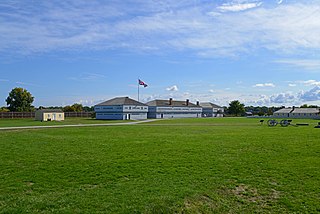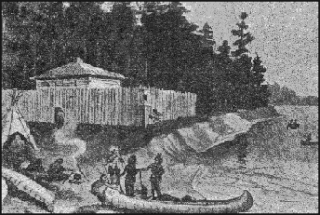
The Canadian National Exhibition (CNE), also known as The Exhibition or The Ex, is an annual event that takes place at Exhibition Place in Toronto, Ontario, Canada, during the final 18 days leading up to and including Canadian Labour Day, the first Monday in September. With approximately 1.5 million visitors each year, the CNE is Canada's largest annual fair and the sixth largest in North America. The first Canadian National Exhibition took place in 1879, largely to promote agriculture and technology in Canada. Agriculturists, engineers, and scientists exhibited their discoveries and inventions at the CNE to showcase the work and talent of the nation. As Canada has grown as a nation, the CNE has reflected the growth in diversity and innovation, though agriculture and technology remain a large part of the CNE. For many people in the Greater Toronto Area and the surrounding communities, the CNE is an annual family tradition.

Fort George was a military fortification in Niagara-on-the-Lake, Ontario, Canada. The fort was used by the British Army, the Canadian militia, and the United States Armed Forces for a brief period. The fort was mostly destroyed during the War of 1812. The site of the fort has been a National Historic Site of Canada since 1921, and features a reconstruction of Fort George.

Fort York is an early 19th-century military fortification in the Fort York neighbourhood of Toronto, Ontario, Canada. The fort was used to house members of the British and Canadian militaries, and to defend the entrance of the Toronto Harbour. The fort features stone-lined earthwork walls and eight historical buildings within them, including two blockhouses. The fort forms a part of Fort York National Historic Site, a 16.6-hectare (41-acre) site that includes the fort, Garrison Common, military cemeteries, and a visitor centre.

Exhibition Place is a publicly owned mixed-use district in Toronto, Ontario, Canada, located by the shoreline of Lake Ontario, just west of downtown. The 197-acre (80 ha) site includes exhibit, trade, and banquet centres, theatre and music buildings, monuments, parkland, sports facilities, and a number of civic, provincial, and national historic sites. The district's facilities are used year-round for exhibitions, trade shows, public and private functions, and sporting events.

Metro Toronto Convention Centre, is a convention complex located in Toronto, Ontario, Canada along Front Street West in the former Railway Lands in Downtown Toronto. The property is today owned by Oxford Properties. The centre is operated by the Metropolitan Toronto Convention Centre Corporation, an independent agency of the Government of Ontario.

The Western Heights of Dover are one of the most impressive fortifications in Britain. They comprise a series of forts, strong points and ditches, designed to protect the country from invasion. They were created in the 18th and 19th centuries to augment the existing defences and protect the key port of Dover from both seaward and landward attack; by the start of the 20th century Dover Western Heights was collectively reputed to be the 'strongest and most elaborate' fortification in the country. The Army finally withdrew from the Heights in 1956–61; they are now a local nature reserve.

New Fort York, later the Stanley Barracks, is a former British and Canadian military base in Toronto, Ontario, Canada, located on the Lake Ontario shoreline. It was built in 1840–1841 to replace Toronto's original Fort York at the mouth of Garrison Creek as the primary military base for the settlement. Unlike the older fort, many of the new fort buildings were made with limestone instead of wood. A protective wall was planned for the new fort but was never built. The fort was used by the British army until 1870, and the Canadian military subsequently used the fort to train troops for the Second Boer War, World War I and World War II. It also trained one of the first regiments of the North-West Mounted Police. The Canadian military stopped using it after World War II and the fort was demolished in the 1950s. Only the Officers' Quarters building remains on the site.

Coca-Cola Coliseum is an arena at Exhibition Place in Toronto, Ontario, Canada, used for agricultural displays, ice hockey, and trade shows. It was built for the Canadian National Exhibition (CNE) and the Royal Agricultural Winter Fair in 1921. Commonly known as the Coliseum, it was formerly known as the CNE Coliseum and Ricoh Coliseum, and since 1997 it has been part of the Enercare Centre exhibition complex. It serves as the home arena of the Toronto Marlies ice hockey team, the American Hockey League farm team of the Toronto Maple Leafs. For the 2015 Pan American Games the venue hosted the gymnastics competitions and was known as the Toronto Coliseum.

Dufferin Street is a major north–south street in Toronto, Vaughan and King, Ontario, Canada. It is a concession road, two concessions (4 km) west of Yonge Street. The street starts at Exhibition Place, continues north to Toronto's northern boundary at Steeles Avenue with some discontinuities and continues into Vaughan, where it becomes York Regional Road 53. The street is named for Frederick Hamilton-Temple-Blackwood, 1st Marquess of Dufferin and Ava, who served as Governor General of Canada from 1872 to 1878. Prior to 1878 the street was labelled as Western City Limits or Sideline Road south off Bloor. In 2003 and 2007, it was voted as one of "Ontario's Worst 20 Roads" in the Ontario's Worst Roads poll organized by the Canadian Automobile Association.

Fort Rouillé was a French trading post located in what is now Toronto, Ontario, Canada. Fort Rouillé was constructed by the French in 1751, building upon the success of a trading post they established in the area a year earlier, known as Fort Toronto. Fort Rouillé was named for Antoine Louis Rouillé, who at the time of its establishment was Secretary of State for the Navy in the administration of King Louis XV of France. It served as a trading post with the local indigenous peoples from the region.

Government House was the official residence of the Lieutenant Governor of Upper Canada and Ontario, Canada. Four buildings were used for this purpose, none of which exist today, making Ontario one of four provinces not to have an official vice-regal residence.

Scadding Cabin is a 1794 log cabin on the grounds of Exhibition Place in Toronto, Ontario, Canada. It was built by John Scadding and is now the oldest surviving building in Toronto.

Exhibition Loop is the terminus for the 509 Harbourfront and 511 Bathurst streetcar routes, the 174 Ontario Place-Exhibition, and the 307 Blue Night Bathurst bus routes. Exhibition Loop serves Exhibition Place, Coca-Cola Coliseum, BMO Field and connects with GO Transit at the Exhibition GO Station.

The Automotive Building is a heritage building at Exhibition Place in Toronto, Ontario, Canada, containing event and conference space. In the 1920s, as a result of burgeoning interest in automobiles, additional exhibition space for automotive exhibits during the annual Canadian National Exhibition (CNE) was needed. A design competition was held, and the winning design was submitted by Toronto architect Douglas Kertland. The building opened in 1929, and the "National Motor Show" exhibit of automobiles was held in the building until 1967. It was also used for trade shows. When it opened, it was claimed to be "the largest structure in North America designed exclusively to display passenger vehicles". During World War II, the building was used by the Royal Canadian Navy and named HMCS York. After the end of automotive exhibits at the CNE, the building was used for other CNE exhibits and continued to be used for trade shows.

Fort Buford was a United States Army Post at the confluence of the Missouri and Yellowstone rivers in Dakota Territory, present day North Dakota, and the site of Sitting Bull's surrender in 1881.

Fort Wellington National Historic Site is a historic military fortification located on the north shore of the St. Lawrence River at Prescott, Ontario. The military fortification was used by the British Army, and the Canadian militia for most of the 19th century, and by the militia in the 20th century, until 1923, when the property was handed over to the Dominion Parks Commission, the predecessor to Parks Canada. The fort was earlier named a National Historic Site of Canada in January 1920.

The Toronto Maritime Museum or Toronto Waterfront Museum or The Pier Museum was a museum in Toronto, Ontario, Canada. It celebrated the history of the Toronto waterfront, the history of commerce on the Great Lakes, and the role of maritime commerce in the development of the City of Toronto.

The Enercare Centre, formerly known as the Direct Energy Centre and originally the National Trade Centre, is an exhibition complex located at Exhibition Place in Toronto, Ontario, Canada. It is used by the Canadian National Exhibition and the Royal Agricultural Winter Fair, as well as by various trade shows. In 2015, it hosted several sport competitions and the broadcasting centre for the 2015 Pan American Games.

The Princes' Gates is a triumphal arch and a monumental gateway at Exhibition Place in Toronto, Ontario, Canada. Made out of cement and stone, the triumphal arch is flanked by colonnades on both of its sides, with curved pylons at both ends. The 350-foot-long (110 m) structure serves as the eastern gateway to the Canadian National Exhibition, an annual agricultural and provincial fair held at Exhibition Place.

The Government Building, also known as the Arts, Crafts and Hobbies Building, is a heritage exhibition building at Exhibition Place in Toronto, Ontario, Canada. Built in 1911 for the annual Canadian National Exhibition (CNE), the building has been used since 1993 as the Toronto location of the Medieval Times chain of dinner theatres.





















